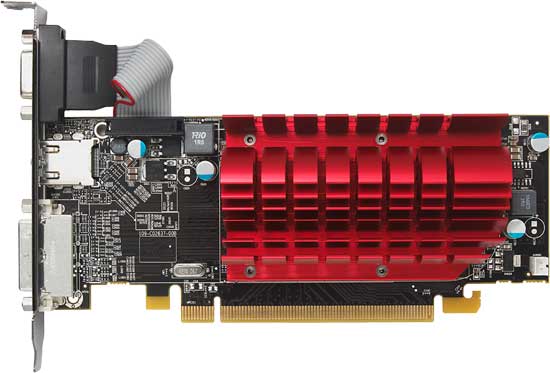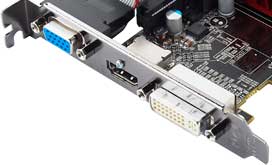AMD’s Radeon HD 5450: The Next Step In HTPC Video Cards
by Ryan Smith on February 4, 2010 12:00 AM EST- Posted in
- GPUs
Meet the 5450
As luck would have it, we ran in to a bit of a snafu yesterday morning when wrapping up our test of the 5450. As we stated in our intro, the DDR3 Radeon 5450 is supposed to be clocked at 650MHz core and 800MHz memory, but that’s not what we got. Internally AMD has been sampling a 650MHz/900MHz card for one of the OEMs they work with, and a few of those samples made it out with the 650MHz/800MHz review samples for the press. As one of the (un)lucky winners, we received a 650MHz/900MHz sample, meaning our card isn’t quite a reference card. Thankfully we have more than one 5450 and we were able to benchmark a stock-clocked Sapphire card, but keep in mind a proper built-to-reference card is going to be equipped with slightly different RAM than our sample is. Besides the RAM chips, everything else about our sample is the same as a reference card.

With that out of the way, the 5450 is intended to be a replacement for both the Radeon 4350 and the Radeon 4550. The former was AMD’s previous low-profile card, while the latter was the DDR3 equipped version. Thus we have something similar in size and power usage as the 4350, but packing the “complete” abilities of the chip like 4550.
The 5450 AMD is sampling is the 512MB DDR3 version, for which the reference clocks are 650MHz core, 800MHz (1600MHz data rate) memory, and a 64bit bus giving it 12.8GB/sec of memory bandwidth. There will also be 5450s released using DDR2 (which unfortunately will share the 5450 name), and AMD tells us that vendors have the option of equipping their cards with either 512MB or 1GB of memory. So we’re potentially going to see 4 different 5450 configurations, with the possibility of 1-2 more if any vendors go ahead and build 900MHz DDR3 cards for public purchase.
The reference 5450 is a low-profile card, measuring 6.61” long (the same as the 5670). The low 19.1 TDP means that it can be passively cooled, and as such AMD has equipped it with a double-wide heatsink. This differs slightly from the 4350, where the reference card was actively cooled and the vendor cards were almost entirely passively cooled. There is a 2pin fan header near the back of the card to allow active cooling, but we aren’t immediately expecting anyone to go that route.
The card is equipped with 4 Samsung DDR3 900MHz RAM chips, 2 on the front and 2 on the rear. Note that the 900MHz RAM chips are an artifact due to the fact that this is the wrong sample card. A regular DDR3 5450 such as our Sapphire card would be equipped with 800MHz RAM chips instead.
Anyone hoping to push a bit more out of the 5450 is going to find themselves disappointed when it comes to pure reference cards. AMD has disabled Overdrive by default on these cards, leaving it up to the card vendor to decide if they want to offer it or not.

Finally, since the 5450 is a low-profile card, we have yet another variant in the port configuration. Our sample card is equipped with 1 DVI port and 1 DisplayPort directly on the card, and a VGA port on the bracket attached to the card via cable. The 5450 – like all other 5000-series cards – supports 3-monitor Eyefinity, so all 3 ports can be used at once, although the VGA port is obviously going to make it less desirable here.
We should note that only cards with a DisplayPort will support Eyefinity, which means that if a vendor decides to equip the card with an HDMI port instead, they have to give up Eyefinity to do so. We expect to see some cards with HDMI for the HTPC crowd, but at this point we don’t have any idea as to how many there will be. DVI-to-HDMI adaptors still work here, so we may see vendors spend a bit more money and go that route instead.










77 Comments
View All Comments
andy o - Thursday, February 4, 2010 - link
So far the most reasonable explanation I've seen by googling is someone if a forum suggesting that its function is just disabling certain features so as to prioritize smooth playback over those features. I don't see any difference with the 5770, otherwise (with that card it doesn't disable anything).UNCjigga - Thursday, February 4, 2010 - link
I sort of assumed it was similar to what 120hz/240hz LCD TVs do: use a frame doubler to more closely match your monitor's refresh rate and give the impression of "smooth" motion.andy o - Thursday, February 4, 2010 - link
I don't think so, most PC displays are 60 Hz, and I think even most 120 Hz TVs only take up to 60p input. There's only a couple of 120Hz-input monitors.therealnickdanger - Wednesday, February 10, 2010 - link
Actually, most CRTs using analog connections are capable of 120Hz. DVI, HDMI, and DisplayPort do not support digital transmission speeds over 60Hz. It's a sad state of affairs if you ask me.sc3252 - Thursday, February 4, 2010 - link
I know this isn't exactly supposed to be a fast card, but its clocked ~10% faster yet its slower than the last generation card... I can't say I am surprised though, after seeing the 5770 clocked faster than the 4870 yet being around the same speed.StevoLincolnite - Thursday, February 4, 2010 - link
I think people are missing allot of the big picture here and that's Crossfire with the Radeon 54xx series.Specifically with the new 8 series of chipsets, hence the amount of shaders present, I expect a return of Hybrid Crossfire.
Pairing an IGP with a low-end card is a very cost effective solution to getting more performance out of a system and also gives AMD an edge in getting more people to buy an AMD Processor+Chipset+Graphics card.
ereavis - Thursday, February 4, 2010 - link
"me too" I'd dig a 758G Hybrid Crossfire review with this and the other sub $100 Radeons (if they support x-fire) 785 was a great motherboard to match with the Athlon II and Phenom II X2-X3, some of us were waiting on video card purchases and would like to see Crossfire 54XX/56XX compared to a 5750 discrete for example.JarredWalton - Friday, February 5, 2010 - link
Fun fact: HD 5450 is about 40% faster than my pathetic old 7600 GT in my work PC. Remember when 6600 GT was da bomb? LOLQuietOC - Thursday, February 4, 2010 - link
The 80 shader discrete Radeons are just too limited by 64-bit DDR3. The 785G has more bandwidth and the same number of ROPS (mine even runs fine at 1GHz.) If they had cut the power usage of the 5450 down a lot more it may have made some sense.Totally - Thursday, February 4, 2010 - link
5770 128-bit bus, 4870 256-bit busagain 5450 64-bit bus, 4550 128-bit bus